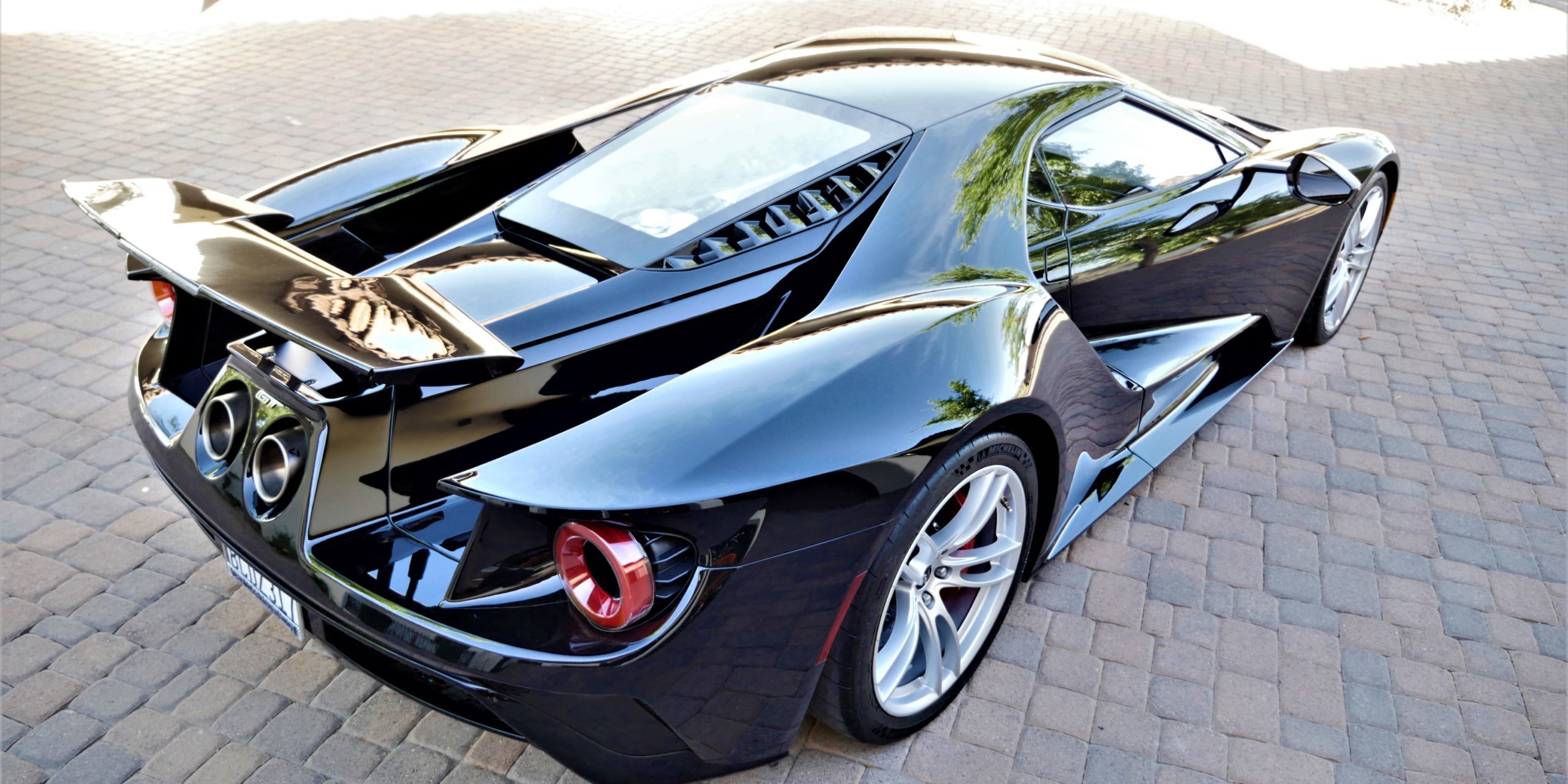2015 Ford GT
Class/Category: Exotic/Supercar/Hypercar/Sportscar
Ford GT Limited Edition

Details
The design of the new Ford GT began with its aerodynamics package, which was closely related to the ultimate focus of the design team of creating a successful Le Mans race car. Low downforce and aerodynamic efficiency were of primary importance in the development of the exterior of the car, and this drove designers to pursue a ‘teardrop profile’ as often seen in LMP1 cars. The powertrain of the new GT, therefore, became a secondary criterion to the external design and aerodynamic performance of the car. Although a V8 and even a V12 engine were both considered, it was ultimately decided to use Ford’s EcoBoost V6 engine due to the degrees of freedom that the compact engine gave designers.
The intent behind the design was for the overall look of the second generation GT to be recognizable as a part of the GT line, which meant, for example, a cut back front nose piece, circular tail lights, and raised twin exhaust pipes. There was no explicit requirement for luxury or practicality in the design of the road car, which is the reason behind the car’s negligible cargo space and spartan interior. The interior seating position was fixed to provide additional space for the bodywork and teardrop exterior shape.
Like its predecessor, the new Ford GT is only offered as a 2-door coupe with the mid-rear layout, for the purpose of improved stability by keeping the center of gravity near the middle. The new GT’s weight distribution is 43% front and 57% rear. Unlike the first generation car, the new GT has butterfly doors that no longer include a piece integrated into the roof.
The car is powered by a 3,496 cc (3.5 L; 213.3 cu in) twin-turbocharged Ford EcoBoost V6 engine rated at 647 hp (482 kW; 656 PS) and 550 lb⋅ft (746 N⋅m) of torque. The engine shares many components with the F-150’s 3.5 L V6 engine including the cylinder heads, block and dual fuel system. Notable differences include larger turbochargers, an aluminum intake manifold, a custom dry sump lubrication system, unique camshafts and higher strength rotating and timing drive components.
The engine is paired to a Getrag 7DCL750 7-speed dual-clutch transmission.
Underpinning the new GT is a carbon fiber monocoque bolted to aluminum front and rear subframes covered in carbon fiber body panels. The windshield of the vehicle is made of Gorilla Glass manufactured by Corning, which is also used for manufacturing smartphone screens. The Gorilla Glass is used to reduce the weight of the vehicle by allowing for a thinner windscreen with the same strength as a normal glass windscreen. The GT employs a four-stage external dry sump oil pump and has an oil capacity of 15.3 US quarts (14.5 L).
The new GT uses a pushrod suspension system, which move the primary components of the suspension inboard and provide space for the large aerodynamic elements in the bodywork of the car. The suspension is hydraulically adjustable, and the ride height can drop from 4.7 inches (120 mm) in comfort mode to 2.8 inches (70 mm) in Track or Vmax modes. These drive modes also dynamically adjust the dampening component of the suspension, which consists of two springs stacked in series. In Track and Vmax modes, one of these springs is completely locked to increase the overall spring rate of the system. The car also has a front-axle lifting system for clearing road obstacles and steep entry angles.
The wheels have a diameter of 20 inches at the front and rear, and come equipped with Michelin Pilot Sport Cup 2 tires with codes of 245/35 R 20 for the front and 325/30 R 20 for the rear. The brakes are ventilated carbon-ceramic discs made by Brembo, with six-piston calipers at the front and four-piston calipers at the rear.
The most prominent exterior features of the new GT are the open airflow tunnels built into the rear fenders of the car, referred to as the ‘flying buttresses’. These large aerodynamic elements, enabled by the compact V6 engine and pushrod suspension design, channel air around the teardrop-shaped cockpit over the rear spoiler for increased downforce. The front end of the GT features a GT40-inspired cutaway nose and vents in the hood that pass oncoming air over the top of the car. The rear features a large diffuser and hollow circular tail lights that expel air taken in by vents built into the flying buttresses.
The active rear spoiler of the GT can adjust and adapt to different driving conditions and modes depending on how much downforce is needed. In Track mode, a gurney flap will extend from the trailing edge of the wing to further increase downforce, and the wing will flip vertical to help stop the car under heavy braking.
The new GT has a claimed top speed of 216 mph (348 km/h), and has a power to weight ratio of 0.43 hp (0.32 kW) per kilogram. In steady-state cornering on a skidpad, the GT can achieve 1.11 g of lateral acceleration, and the car is capable of braking from 70 mph (113 km/h) to a stop in 145 ft (44 m). Independent acceleration figures are provided below:
1⁄4 mile (402 m): 10.8 seconds at 134 mph (216 km/h)
0-60 mph (97 km/h): 3.0 seconds
0-100 mph (161 km/h): 6.2 seconds
Vehicle Video
Vehicle Awards
Barry is the third generation President of Meguiar’s Car Wax, who took Meguiar’s into the retail market in 1973 and it became the top selling Car Wax in America. His TV Show ‘Car Crazy’ ran for 18 years and aired on Discovery Networks world-wide. He’s been the Grand Marshall for many events from the Woodward Dream Cruise to the Copperstate 1000, honored as Icon of the Year by the Petersen Automotive Museum and inducted into the SEMA Hall of Fame.
His cars are a joint passion with Karen, his wife of 57 years, who’s also a Car Guy. They decide together which cars to buy for reasons that are personal to them. It was Karen who talked Barry into buying the Ford GT. While they don’t call themselves Car Collectors, they’ve collected a few cars that stir their personal emotions and they love to drive.
























